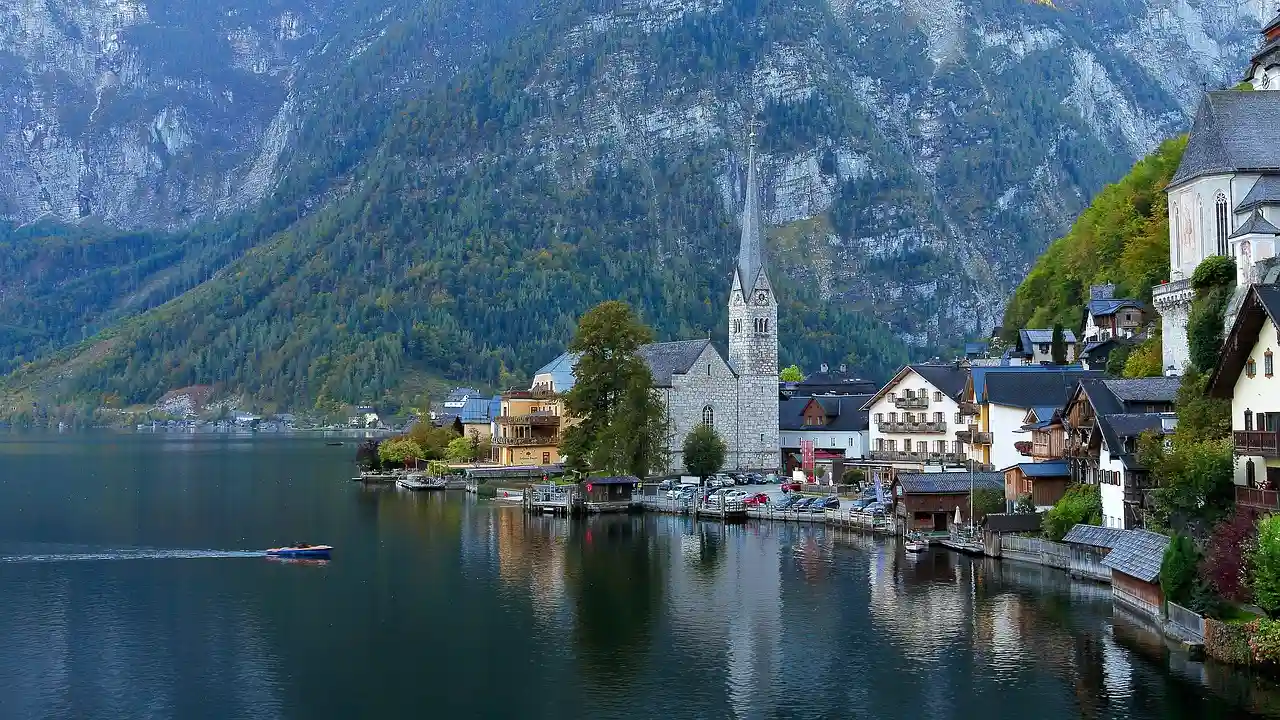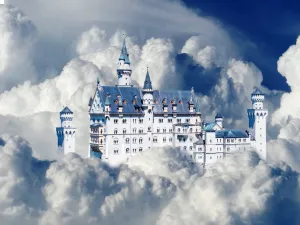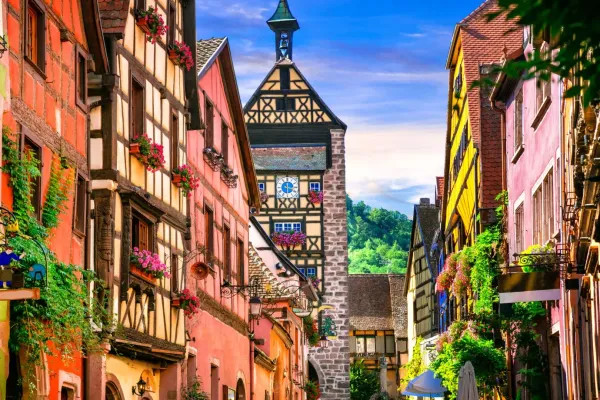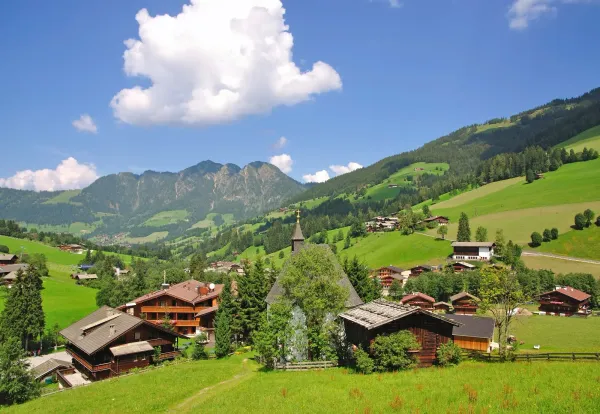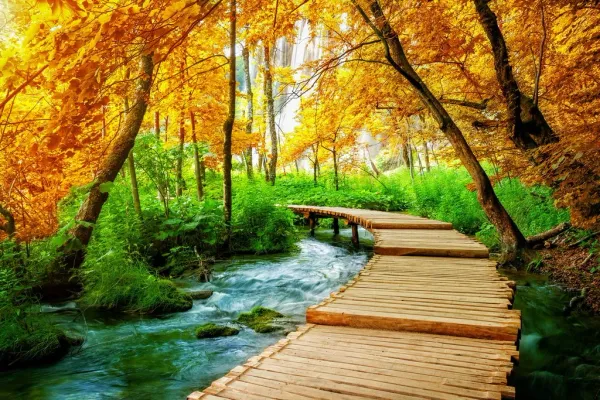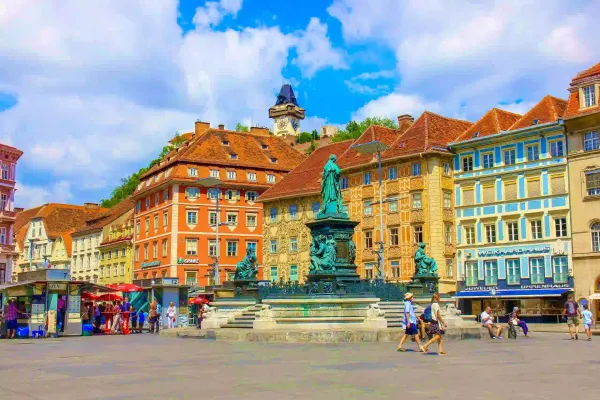If you're looking for a fairy-tale-like setting perfect for your next vacation, look no further than Hallstatt - that has long captivated the hearts and imaginations of travelers from all around the world.
Nestled in the breathtakingly beautiful Salzkammergut region of Upper Austria, the tiny village of Hallstatt lies at the foot of majestic snow capped Dachstein Mountains - overlooking crystal clear and calming Lake Hallstatt (Hallstätter See) - just 80 kilometers from Salzburg, 180 kilometers from Graz and 300 kilometers away from Austria’s capital city Vienna.
Despite its size and with less than 1000 inhabitants, there is no shortage of attractions and things to do in Hallstatt and its surroundings.
Adventure seekers can explore the hiking trails and climb to the top of the Dachstein Krippenstein and enjoy breathtaking views of Lake Hallstatt and the surrounding area from the 5 Fingers observation deck.
Those who like history have the opportunity to join an interesting and informative tour of the Hallstatt Salt Mines. On the other hand, for scary sensations, visit the St Michael's Chapel - home to mystical 'Bone House'. Unearth a truly unique experience!
Hallstatt is ideal for walking, although the narrow cobbled streets that wind up and down between centuries-old chalets are usually crowded with tourists. More than a million visitors stop here every year to capture the magic of this UNESCO heritage site. A leisurely walk through the small, symbolic village of Austria takes 2-3 hours, and it is almost impossible to get lost.
What can you see in Hallstatt without amazing scenery?
In this blog post we'll cover some of the top attractions that you won't want to miss when you visit this unique destination!
Fun fact: Hallstatt is so awesome that China decided to build a replica of the village in 2011. Now similar views to Hallstatt can be seen in Huizhou city of China. Hallstatt Mayor Alexander Scheutz participated in the inauguration ceremony of the Chinese Hallstatt Town in 2012, where he signed a cultural exchange agreement.
1. Hallstatt Salt Mine
It would be a sin not to take advantage of the opportunity to take a tour to the world's oldest salt mine when you visit Hallstatt.
Afterall, it's not every day you can find an ancient salt mine with over 7000 years of history! The Hallstatt Salt Mine, or more commonly known as Salzwelten Hallstatt, which literally means World of Salt, is located more than 270 meters above the dreamy village of Hallstatt.
Salzwelten Hallstatt has been around since prehistoric times and was used by the Celts and even the Romans. The so-called "White Gold" was during the Middle Ages that it became a major source of wealth for locals, as salt was a valuable commodity long before refrigeration. The mine stayed in operation up until 1965 when it closed due to safety concerns, but now it is open to visitors who want to explore its depths.
This fantastic guided tour offers a wide range of family-friendly activities that will take everyone back to prehistoric times.
Also, it is especially suitable in bad weather, for example on rainy days when there is nothing else to do.
Before going into the depths of the salt mine, everyone will be dressed in a miner's costume, and then the exciting attractions will begin.
Just like the miners of old time, you will have the opportunity to slide down two miner's slides, one of which is particularly exciting with a length of 64 meters, which will record your speed and capture it in a photograph that you can buy later.
Once you descend into the mine, you will enter an awe-inspiring underground world. You can explore centuries-old tunnels, an underground salt lake, learn interesting facts about the legendary "Salt Man", which, by the way, was found 300 years ago and was actually perfectly preserved, as well as learn about the mining process. In addition, watch a “Bronze Age Cinema” which is set up 400 meters below ground, which especially highlighted the world's oldest found wooden stairs, which archaeologists found in Salzwelten Hallstatt in 2002, and they are believed to be about 3000 years old.
To get up to the Hallstatt high valley where the salt mine is located you have two options; either take the Salzwelten panoramic Funicular which takes about three minutes and offers breathtaking views and experiences as well, or go up the winding old miners' path (Salzweg) which is about an hour long hike from the center of Hallstatt and also offers stunning views.
Good to know!
The combined ticket, which also includes an elevator, a visit to the Salt Mine, Prehistoric Necropolis and some other activities, costs 40 euros for an adult and 18 euros for a child.
Those who go hiking and do not use the Salzbergbahn entrance ticket costs 27 euros for adults and 13.50 for children. (as of 2023)
Children enter the salt mines from the age of 4.
The full guided tour will last approximately 3 hours, prepare a warm jacket as the temperature inside the mine is more or less 8 degrees all year round.
Hallstatt Salt Mine is closed in the period from January to February.
Detailed information about the Hallstatt Salt Mine prices, discounts and opening hours can be found here.
Read also: Places to visit in Vienna
2. Check out the "World Heritage View" from the Hallstatt Skywalk
Salt mines are not all you can see when you are up on the Hallstatt high Valley. Just a short distance across the 74-meter steel footbridge that spans the gorge, enjoy stunning "World Heritage View'' of Hallstatt below and its lake surrounded by the snow-capped peaks of the Alps in the Dachstein Salzkammergut region.
The Hallstatt Skywalk is a V-shaped free floating walkway that hangs 12 meters from the cliff face and 360 meters above the village of Hallstatt.
This relatively new tourist attraction (opened in 2013) is located directly below the former defense tower Rudolph's Tower (Rudolfsturm), which was built to protect the salt mines of Hallstatt.
Now the Rudolph Tower is home to a restaurant with a terrace that offers views just as enchanting as the Hallstatt Skywalk, just with a cup of coffee or feasting on local food.
Unlike the Hallstatt Salt Mine, the Hallstatt Skywalk does not cost you anything to visit, as long as you choose to hike the picturesque serpentine path, which, as mentioned earlier, will take about an hour.
Otherwise, head to the Salzbergbahn station and take a scenic 3-minute ride up the Salzberg.
Good to know!
The Salzwelten Funicular railway costs 12 euros for adults and 6 children in one direction, and 22 and 11 euros in both directions. (as of 2023)
There are also some discounts available for students, families, seniors and Salzkammergut card holders.
Read also: Best sights & things to do in Wachau Valley, Austria
3. Hallstatt's Old Town and Market Square
Hallstatt's small market square (Marktplatz), located right in the center of Hallstatt's old town, is surrounded by traditional, beautifully colored houses with wooden balconies decorated with flowers.
In 1750, tragedy struck Market Square when a devastating fire ripped through the area. The buildings were reconstructed with resilient stone that contrast beautifully against the older timber homes throughout town - creating an interesting mix of old and new architecture.
The square is lined with shops, excellent restaurants and benches where you can sit and enjoy the unique atmosphere of the World Heritage town of Hallstatt, but one of the main features is the elegant statue of the Holy Trinity, which was a gift from the imperial salt master in 1743, by the way, there is also a similar one in Vienna.
Hallstatt Market Square is an ideal place to drink coffee, eat ice cream or buy a souvenir. Residents here organize various holidays, festivals (usually religious) or concerts throughout the year.
Just a step away from the Marktplatz is the Evangelical Church, which has become the symbol of this small mountain village. It is visible in most of the photos taken in Hallstatt, and the visual impact is more intense when viewed from a distance.
Its construction began in 1785 after Emperor Francis Joseph I issued a decree recognizing the Protestant religion and allowing its free practice in the empire.
Read also: Places to visit near Salzburg, Austria
4. World Cultural Heritage Museum Hallstatt
The Hallstatt World Heritage Museum (Welterbemuseum Hallstatt) is an amazing destination for travelers looking to explore the historical roots of the ancient salt mining town, dating back 7,000 years.
This museum brings history to life with interactive exhibits and displays that will fascinate children and adults alike.
The interactive displays inside the museum are designed to give you a better understanding of how Hallstatt came to be and how it evolved over time.
You'll learn about how the Iron Age was named after Hallstatt, as well as the Great Fire of 1750 which gave rise to new architecture in the town.
From video animations and 3D presentations to cycloramas and dioramas, holographic representations and more, these interactive exhibits make learning about history fun for all ages.
When visiting the museum, it is worth seeing the archaeological excavations located under the Dachsteinsport Janu store.
The shop is located across from the World Heritage Museum and reveals remains from different eras like ancient tools used by miners many years ago, pottery shards from long-gone civilizations, coins from olden days – all sorts of fascinating artifacts can be found here!
Good to know!
The entrance fee is 10 euros for an adult and 8 for a child, various discounts are available. (as of 2023)
Read also: Top Attractions & things to do in Salzburg, Austria
5. Catholic Church & Cemetery
Leaving the square and walking up a narrow and winding street, you reach the 15th-century Roman Catholic Parish Church. This church is worth visiting for several reasons:
First of all, because the church contains significant Gothic works of art that were stolen in the 80s, but miraculously returned to their places after 40 years, i.e. in 2018.
Secondly, from the small rather narrow, but excellently maintained church cemetery, there is a charming view of both Hallstatt and the Hallstatt lake. And no matter how unusual it may seem, these cemeteries are a peaceful and beautiful place to walk around.
Thirdly, it is on the way if you go to take stunning photographs from the popular Hallstatt viewpoint.
Fourth, it can be visited completely free of charge.
And fifthly, nearby is St. Michael's Chapel, which is home to the world-famous Bone House.
Read also: Best Tourist Attractions in Portugal
6. Bone House in St. Michael’s Chapel
Hallstatt has always been known for its beauty, but its special traditions, characterized by attractions such as the Bone House (Beinhaus), set it apart from any other destination.
The Bone House, which is perched in St. Michael's Chapel has a unique cemetery with an unusual view that deserves its world-famous status.
Located next to a Catholic parish church, this 12th-century chapel houses more than 1,200 exhumed human bones neatly arranged along its walls.
The history of this Bone House in Hallstatt dates back to the beginning of the 17th century - when the establishment of burial places in Hallstatt was limited and since cremation was not allowed by the Catholic Church, another solution had to be found. Ultimately, the city decided to exhume the bodies of the recently deceased ten to twenty years after their initial burial.
The bones were then cleaned, left in the sunlight to fade, and later moved to the lower level of St. Michael's Chapel, where they were then arranged in careful interlocking rows of relatives. In this way, new places were freed up in the Hallstatt cemetery.
But what makes Hallstatt's Bone House stand out? Not only skulls and bones can be seen in this Bone House, it stands out with ornately decorated skulls. This tradition of decorative skull painting dates back to the mid-18th century and today houses over 600 intricately painted skulls.
In the beginning, they were painted only with flowers, later names and surnames, dates of life and other symbolic drawings were added to them.
The transfer of bones to the Bone House began to disappear in the middle of the 20th century, when cremation was recognized.
The last skull was added in 1995, when a deceased woman had written it as her last wish in her will.
Well that sounds exciting right?
Tip: If you like walking, it is highly recommended to combine a visit to the Bones House with a short walk along the "Hallstätter Höhenweg". It starts at the back of the cemetery, leads a few steps up to a beautiful viewpoint called "Marienruhe" and continues to the Hallstatt Funicular station, passing by the Mühlbach (mill brook) along the way.
Good to know!
The St. Michael's Chapel House of Bones is open every day from 10 am to 6 pm in the summer months, that is from May to September; to 5 pm in the month of October; from 11:30 am to 3:30 pm from November to April.
The entrance fee is 2 euros per adult and 50 cents per child up to 15 years old. (as of 2023)
Read also: Some of the best places to visit in Europe
7. Viewpoint Hallstatt
If you've seen a picture of Hallstatt, where the charming cottages stretch along the water's edge on the right and end at the church with its spire reaching up into the mountains, this is most likely where its photography point was.
The Hallstatt viewpoint (Aussichtspunkt Hallstatt) is located approximately 200 meters from St. Michael's Chapel and its Bone House, and it is so unique because it offers a panoramic angle that allows you to see the whole village. There are also other traditional Hallstatt viewpoints located on the southern side of the village.
This is practically the last sight on the north of the village, so if you want to capture stunning Hallstatt photography, be sure to visit this viewpoint. But not just for photography, everyone can relax here and enjoy the wonderful views before heading back to Hallstatt attractions.
Read also: Visit Dachstein Krippenstein in Obertraun, Austria
8. Lake Hallstatt (Hallstätter See)
Surrounded by mountains up to 3,000 meters high, the deep green shimmering Lake Hallstatt is just over 7 kilometers long with a maximum width of 3.2 kilometers and connects three towns: Obertraun, Bad Goisern and Hallstatt and is one of the most important and impressive lakes in the Alps.
In 1997, together with the village of Hallstatt, it was declared a World Heritage Site by UNESCO.
The clear water is a favorite among the swans and ducks that rule here. In addition, the lake is not polluted, as motorboats are not allowed in the area.
There are many exciting things to do both on and around the lake. From swimming to discovering stunning views.
There are several rental points available in Hallstatt where you can rent pedal boats, rowing boats and sup boards, as well as electric slow-speed motorboats.
One of the most unique attractions is to go on an exciting journey through history with a charming boat trip on traditional Zille boats!
Known locally as Fuhre boats, they are made of wood with a characteristic flat bottom and were originally used to transport salt - now they provide travelers with a great opportunity to explore the lake with the option of signing up for themed tours.
Another, also cheaper - just 3,50 Euro, option is to use the regular liner boat services that run between the piers in Hallstatt and Hallstatt Train Station.
The liner boat runs regularly every day, and if your plan is to go by train to Hallstatt, then the liner boat is definitely what you will use to get from the Hallstatt train station to the beautiful village, because the train station is located on the other side of the lake.
Apart from regular runs, this company also offers a daily cruise on Hallstatt lake.
Meanwhile, swimmers can enjoy water fun at the free public beaches dotted around the lake, the largest of which can be found in Hallstatt, Obertraun and Bad Goisern. The average water temperature between May and September is 18 - 22 degrees.
The public bathing area in Hallstatt is located on the Bathing Island (Badeinsel) south of the village, it is not only a popular swimming spot for locals and tourists, but also offers a great view of the village.
Read also: 10 must-see lakes in Austria
9. Dachstein Giant Ice Cave
Looking for a breathtaking adventure? If so, then a visit to the Dachstein Giant Ice Cave (Dachsteinhöhlen) in the Dachstein Krippenstein Mountains above Obertraun, just 15 minutes from Hallstatt, is just what you need.
Here you can explore an impressive natural wonder discovered in 1910. The ice in this stone cave is formed from the water seeping into it from the cracks and even the waterfall that is in it, inside the cave water freeze forming interesting shaped formations.
To fully enjoy this magical beauty, the giant ice caves of Dachstein are lit up in different colors and music plays in the background.
Good to Know!
Be sure to dress warmly when you go to experience this magic, as the average temperature in the caves is -2 °C (26.6 °F).
The guided tour lasts 50 minutes and is open to visitors of all ages.
The standard price, which includes the cable car to the caves and a visit to the caves, is 40.10 euros for an adult, 36.10 for a young person and 22 euros for a child. As usual, various discounts are available for families, seniors and groups. Check here for current prices and other offers.
And most importantly, the Caves are open to visitors from May to October.
Read also: Visit Dachstein Krippenstein in Obertraun, Austria
10. Five Finger Lookout
While on the Dachstein Krippenstein, you can't miss the amazing views from the Five Finger Viewing Platform.
Five Finger is made of metal and as the name suggests, it has 5 platforms suspended in the air, each of which offers not only an exciting "World Heritage View" but also unique designs, for example, one platform has a glass floor, the other has a hole in the floor, more one has a baroque style frame where the painting is a landscape and possibly you.
Although it was only opened in 2006, it has become one of the most popular attractions in Hallstatt and is also one of the most impressive viewing platforms in the Alps, which tourists from near and far rush to visit.
Five Finger can be visited all year round, and it costs nothing, but you have to take into account, unless you go here on a hike, that you have to take a cable car, which will cost 36 euros for one adult.
But there's a lot to explore here, not just the 5 Finger platform. And in addition, you can combine it with a visit to the Dachstein Giant Ice Cave. No matter how you choose to visit Five Finger, always follow up on the last gondola departure times.
11. Go on an adventure along the Via Ferrata in Hallstatt
The Seewand Via Ferrata (Klettersteig)in Hallstatt is one of the most prestigious and challenging rock climbing routes in the entire Alps, offering breathtaking views for those brave enough to tackle it.
This demanding route requires great physical condition as well as experience via ferrata and a good weather forecast, with no Emergency exit looming somewhere along the way.
The starting point for the Seewand Via Ferrata is at the south end of Lake Hallstatt, between Hallstatt and Obertraun.
Keep in mind, this exhilarating climb is not suitable for beginners or children so some discretion should be exercised when planning your expedition!
Read also: Attractions & Things to do in Graz, Austria
12. Cycling around Hallstatt
Hallstatt itself is relatively small and can be easily explored on foot, but its surroundings are huge, and one of the most popular ways to discover it is cycling. Cycle around the lake and discover new perspectives on Hallstatt and its captivating lake.
And, the East Coast cycle path, which stretches along the shore of Lake Hallstatt from Obertraun to Bad Goisern, is recognized as one of the most beautiful cycle paths in the entire Salzkammergut region.
Along the bike path, discover the deepest part of Lake Hallstatt, which by the way is under the suspension bridge, just behind the Hallstatt train station, and of course views, views and more views.
Explore Bad Goisern, recharge your batteries in one of the cafés before heading back to Hallstatt.
It should be noted that the best way to go back is by the same road, because there is no bike path from Bad Goisern to Hallstatt, only a road that tends to be busy, so you should be especially careful if you decide to go on it.
If you don't have your own bike, don't worry, just like boats in Hallstatt, you can also rent bikes in Obertraun, which is about 9 minutes away by car or bus.
Read also: Attractions and things to do in Bad Ischl, Austria
13. Hiking in Hallstatt
Hallstatt is not only a photogenic alpine village with a Salt Mine and a Bone House, but also an ideal destination for outdoor enthusiasts because it is located among mountains, and where there are mountains, there are hiking trails.
Explore the Salt Brine Trail (Soleweg), which meanders through lush forests alongside the world's oldest salt water pipeline, or head to the picturesque Echerntal valley, filled with crystal clear waterfalls.
For breathtaking alpine views, the hike to Dachstein Krippenstein is the best choice, choose the hike to Gosau if you want to discover a picturesque small lakes in the mountains.
In addition to the long and possibly difficult hiking trails, there are also easy ones located near Hallstatt.
For example, those that lead over the roofs of Hallstatt to the Salzberg, where the Hallstatt Skywalk are located, or take a walk to Bad Goisern on the path that is on the other side of the lake, the same one mentioned above for cyclists.
From more than 20 hiking trails, surely everyone will find the one that suits them.
Well, doesn't that sound like a hike paradise?
Lovely Terra Tips:
So, let's start with how many days are needed in Hallstatt? Several travel Guides usually recommend Hallstatt as a day trip from Salzburg, or Vienna, etc. Yes, it is possible, but only from the nearest cities, for example, Vienna is a more than three-hour drive away. You arrive, turn around three times and drive back...something like that.
In one day it is enough to explore the village of Hallstatt combined with the Salt Mine or the Ice Caves, but not both, and you can also forget about the hiking trails or bicycle trails. If your plan is not to visit these two spectacular places, then one day is enough to explore the village and the attractions you are interested in, climb (or ride) up to the Hallstatt Skywalk, take a boat ride, and maybe climb the Dachstein Krippenstein to enjoy the view from the 5 Finger platform.
If you want to enjoy Hallstatt in all its glory and leisurely visit all the attractions mentioned above, you should count on three days as a minimum.
Next, the best time to visit Hallstatt? Of course from spring to autumn. Why? Because, for example, the Salt Mine is not open for one month in winter, as well as the railway lift. The Dachstein Giant Ice Caves are not open to visitors from November to May. Hiking trails cannot be visited safely due to snow and ice. The same goes for bike trails.
Yes, you can also visit in winter, but you have to expect that a lot of things do not work during this period, and which attractions are open for visitors, they have shortened working hours, the only plus is that there will be much fewer tourists in the winter months.
What else to do in Hallstatt in winter? Skiing, snowshoeing, sledding. Hallstatt itself does not have a ski slope, but there are enough slopes nearby where you can participate in winter activities, such as the Krippenstein Freesports Arena or the SkiRegion Dachstein West.
What to do in Hallstatt when it's raining outside? Well, in rainy weather, the best activities include - Salt Mine tour (three hours), Hallstatt Museum & Archaeological excavations visit (independently), Catholic Church & Bones House (independently), Dachstein Giant Ice Caves (fifty minutes), enjoy Austrian cuisine in one of the restaurants.
Read also: 12 must-see alps villages in Austria
And Finally…Here they are, 13 Top attractions and things to do in Hallstatt. Follow our tips and your visit to Hallstatt will turn into a magical fairytale. Have a nice journey!


